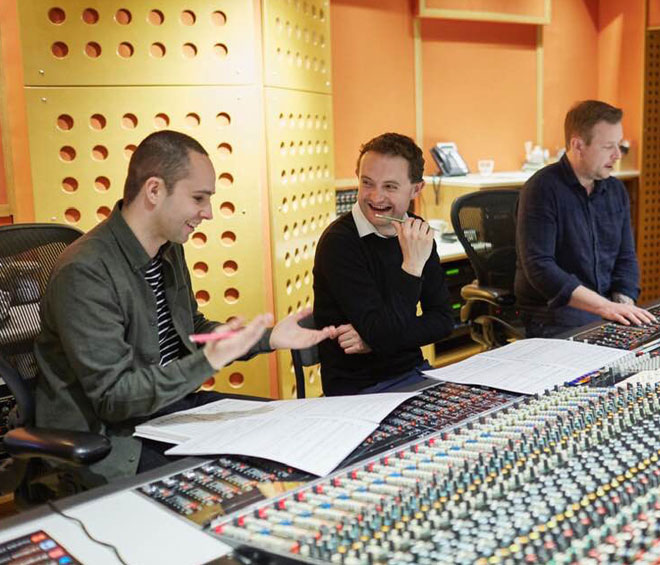
Callum Hüseyin (left), Let’s Finish It. Photo courtesy ICR.
by ANNA McNAY
Callum-Hüseyin (b1993, London) is a composer, conductor and pianist. His work frequently takes the form of collaborations, the most recent of which sees him working with the Institute of Cancer Research (ICR) and the Royal Philharmonic Orchestra (RPO) to create an – as yet – unfinished piece, which is being used in a fundraising campaign to help complete a new building, the Centre for Cancer Drug Discovery, in which the ICR can carry out further life-saving work. The composition, entitled Let’s Finish It, is available on SoundCloud, and there is a music video, showing the musicians and the building site, on YouTube. The idea is to complete the “symphony” at the same time as the building and to perform it in full at the opening. In order to write the music, Hüseyin has immersed himself in research and reading, as well as speaking to the scientists, incorporating their stories into the score.
Studio International spoke to Hüseyin about the collaboration, the process of creating a musical score, and the challenges of being a musician today.
Anna McNay: How did this collaboration between the Institute of Cancer Research (ICR) and the Royal Philharmonic Orchestra (RPO) come about?
Callum Hüseyin: The ICR and the PR firm Cow approached me in the first instance and we got talking about doing something a bit more unusual for a charity campaign. If you go back into classical music history, famous composers have done benefit concerts, but the idea of commissioning an anthem for a building as part of a fundraising campaign, as far as we know, is not something that has been done before, and certainly not for a 21st-century campaign.
We got talking and I suggested a set of orchestras they might want to get in contact with and they arranged to book the RPO, which was thrilling, because they are fantastic players. Some of the members were really into the acting side of things, too, which was really fun on the day in the recording booth.
We spent time talking about what kind of music we wanted, and it was quite a healthy back-and-forth between me and the folks at the ICR and Cow, about what they were interested in, and what they wanted to convey. I’ve always been a collaborative composer. I’m not the sort of romantic person who will often sit and write because I have a need to express myself through music. I do that very rarely, and usually for very personal chamber music, such as my piano sonata. I’m more interested in talking to other people and telling our shared stories together, which is what really appeals to me about this project. It is a terribly interesting project in and of itself and has a lot of fruitful and inspiring elements.
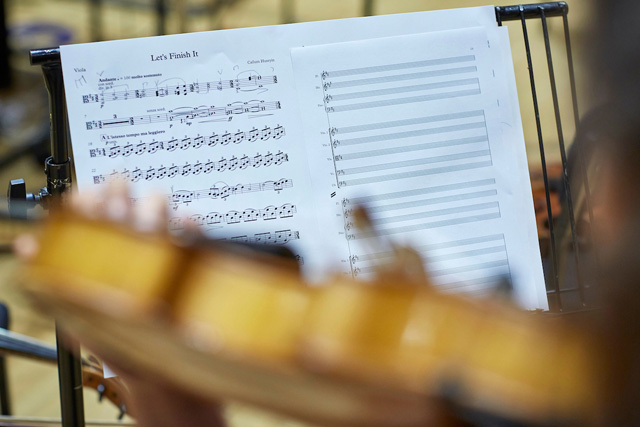
Callum Hüseyin, Let’s Finish It. Photo courtesy Institute of Cancer Research.
My first reaction to the idea of working with a cancer organisation was that it absolutely had to avoid being depressing, but reading through all the information and getting to know more about their plans made me realise it would be something positive and interesting to work on, and full of people coming together from two very different areas of science. I read some of the stories about the scientists’ work, which were inspiring for the music because they provided a different context for cancer. The disease is something we are all intimately acquainted with. We all know people who have been diagnosed with cancer: some who have received excellent treatment and have made recoveries or gone into remission, and others who have gone on a more tragic journey, but not many of us have that much personal experience with the people involved on the other side of cancer – researching and exploring it scientifically. The stories of what it’s like to do research into cancer are inspiring and that is in the music as much as some of the stories you might be more familiar with in terms of what it’s like to live with the illness. That counterpoint is really important and what was striking to me talking to those scientists was that we are living in an age where narratives about cancer are changing. The kind of narrative that existed very much throughout the 20th century was that, sooner or later, you died. But that’s really not the case any more. And once this building is completed, the research that will be undertaken inside it will ensure that it will not be the case for many more people. So it was a lovely creative space to make art in. You can hear that optimism and momentum in the music. And some darkness, of course, and frustration. It’s immensely frustrating for the scientists involved to be on the cusp of something and not to have enough samples or to be very close to something and then have setbacks. That emotional journey really went into the music – and more personal things as well.
AMc: It’s an absolutely beautiful piece. When it stops so abruptly, it really does wrench the listener out of their reverie. To me, it absolutely sounds like a life cut short. Is that one aspect of it?
CH: It is, but it’s bigger than just a personal tragedy. One of the things music has the power to do is not to devalue personal tragedy, but to de-situate personal tragedy and put it into a wider context that connects people – because losing someone to cancer is something that connects everyone. Music has the ability to communicate that as a feeling and it doesn’t matter who it was and who you are, you can have that connection. But also, because music is something that unfolds in time, the fact that you can end things abruptly or heavily implies that a resolution is on the way, it really gives the feeling that this can be solved, we can move forward. In our heads, in our aural imaginations, we have an idea of what might be coming next. You are waiting for the next sound, that’s what creates the feeling. There are, of course, some fantastically heartbreaking, unfinished paintings, but because you view the picture, in general, as a whole, all at once, it’s a different experience. That indrawn breath that isn’t allowed to go anywhere, or the beat from a conductor that doesn’t connect to a downbeat, is one of the most shocking things. I think that’s really one of the reasons that we chose music as a big part of this campaign, because it has that power to shock people out of their reverie in a way that statistics might not be able to.
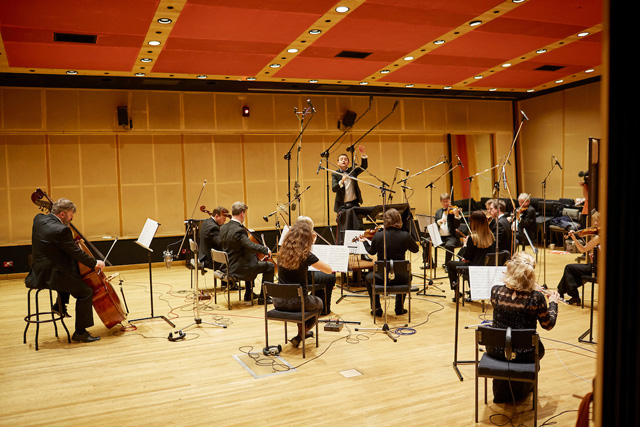
Callum Hüseyin and the Royal Philharmonic Orchestra, Let’s Finish It. Photo courtesy Institute of Cancer Research.
AMc: People are so used to being bombarded with, and surrounded by, statistics these days, but sometimes it is hard to conceptualise them.
CH: It’s interesting you say that people are surrounded by statistics. They are, but they are also surrounded by music nowadays, so I think having disrupted music goes a long way, it really affects the experience. If you go through Instagram or Spotify, you hear a lot of tracks. A lot of them end as they should, and people listen to music without really listening. But if you put disruptions into music – and people have done that throughout musical history: chords where you wouldn’t expect them and odd accents, odd silences – you are able to create a more active listening, and if people, because we have recording technology now, repeat music having experienced that abruptness, they’re probably listening to it more. Replayability is really something that I was looking for with this track. The style is filmic in a way, and that’s very much what we were aiming for, because we wanted to communicate with the largest number of people possible.
I went through a very formal training and can write, and have written, what people might kindly call “squeaky door music”, which is more officially called “avant-garde classical music”. This kind of music is different, though. The music it is most similar to is actually video-game music, because we really wanted people to replay it and hear it again and again. The logic is that, in a concert, the orchestra tends to play a piece once. In film, you don’t start the film again, or you don’t see certain scenes again and again, or, if you do, it’s for a particular reason, and you have dialogue to figure in. Whereas, in a video game, you have loops, the music plays constantly, but it has to be flexible, and people play games more than once because that’s the product’s financial model. So, I looked at some of my favourite video games and explored that kind of epic sound. The overall style, then, is cinematic, which suited the concept of combining the music with some shots of the building site, which has a very powerful aesthetic and is very Instagrammable. The response so far has been very positive. I believe we have had some significant donations already.
AMc: How exactly is the unfinished symphony being used for fundraising? Is it just being put out there on the internet?
CH: The idea is really to connect with individuals, both in a crowdfunding kind of way, for smaller donations, but also with philanthropic high net worth individuals. PR companies and fundraisers know a lot about this sort of thing and have noticed, in recent years, that high net worth individuals like to connect with organisations, particularly through social media and through very specific content and stories that feel personal. But, of course, these social media campaigns are visible to everyone, so we can use something that can be very prestigious, such as classical music, and get it out to a broad range of people. For that reason, the ICR and Cow wanted to tap into particular groups of people that they might not have been associated with before. They thought my music would be a good way of doing that.
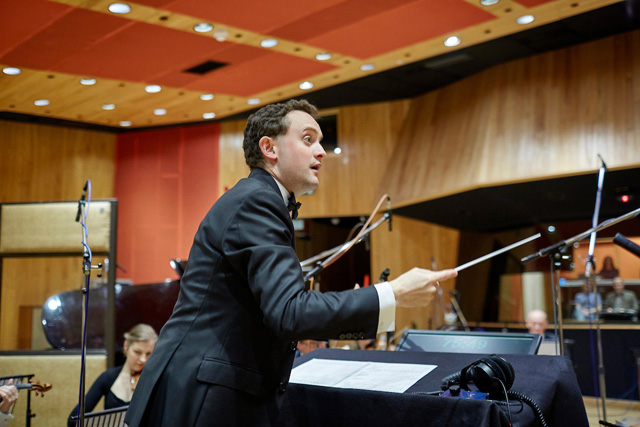
Callum Hüseyin and the Royal Philharmonic Orchestra, Let’s Finish It. Photo courtesy Institute of Cancer Research.
I come from the concert world, so I was apprehensive initially when I was commissioned because it’s not the sort of model I’m used to working with. I’m used to doing lots of rehearsals and trying to get as many people to come to the concert as possible, doing the thing, and then moving on and hoping we’ve covered our costs. You can do albums and records, of course, too, and, again, that’s different, but this is a personal idea with modern digital communications technology getting into people’s bedrooms, their inboxes and direct messaging, and through Instagram stories. It is a really fascinating concept, because lots of things that we do in the concert hall are predicated on music written for 100 to 1,000 or so people in a particular shaped room, who have all come there to listen to that music, probably because they already know it. This is completely different. It is about getting people to listen to something and think and do something. That was a very interesting way of thinking about writing and about how people were going to feel about this note or that note. It was very direct. It was about talking to people. It wasn’t about giving a lecture or mission statement, which music can be full of, because all artists are egomaniacs to a certain extent! It had to be communicative to an audience who may or may not have an interest in classical music.
AMc: Is there any intent to perform the symphony?
CH: Yes. It’s not just part of the fundraising campaign, it’s the official anthem for the building. The fun part is that it’s going to be finished. We will release a finished recording, but we will also be opening the building with it, and it will be having an ongoing relationship with the building. We are thinking about how the relationship might continue. As an organisation, the ICR is very interested in long-term relationships. I think this comes about because the timescale of scientific research is so long. One of the nicest things about this project is how it has brought so many people together: scientists, fundraisers, musicians and others, and that collective endeavour is something that is important for organisations. I hope they don’t put the music in the lifts, but, other than that, it will have a relationship with the building, whether we expand it into a big concert piece of 40 minutes or – who knows?
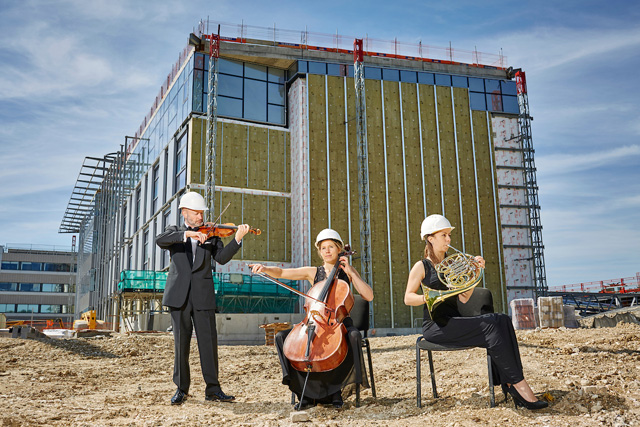
Callum Hüseyin and the Royal Philharmonic Orchestra, Let’s Finish It. The Centre for Cancer Drug Discovery building site. Photo courtesy Institute of Cancer Research.
AMc: So the idea is that the symphony is currently unfinished and it will only be completed once the funding to complete the building has been raised?
CH: It will be finished when the building itself is finished.
AMc: I have no idea about the process of composing a symphony, but is it not unusual for you to get this far into the work and not know the ending? Do you truly not have an idea of how you are going to finish it, or do you have it part written, but just concealed?
CH: Everyone has ideas. When you are training to be a composer, you are taught clever ways of doing the next thing, how to write the next bar, and how to work with what you’ve got in order to write the next bit. It could have lots of different endings, but the emotional story of the piece isn’t finished as yet. Quite how it ends will be predicated on the individual experiences and stories of the campaign; the way that different donors tell stories to the ICR. Without the campaign being finished, we can’t know for certain how the music will end. I can imagine different things, and there are certain constraints, time signatures and so on. And we will want closure on the melodic ideas. The melodies will need to have a satisfying ending, but melodic shapes suggest satisfying resolutions for themselves. As I say, the precise journey is up to everyone involved in the campaign and how they inspire me. I have to collect all of that together.
AMc: So you are being told myriad stories and then translating them into the music?
CH: Yes, I’m interpreting them and having my own views about them and putting them into dialogue with both the earlier stories we have already had and the musical material, which, of course, is informed by those stories, and I am summing it up. There are some personal stories in there, too. It’s a most thrilling way of writing music. I did another project once, which was vaguely similar, where I worked with some academics and art curators who were studying medieval objects. It was more their stories of studying the objects that inspired the pieces I created, as well as the objects themselves. The objects were all very interesting, but I didn’t want to just make things that sounded medieval or try to translate the sound of an ivory casket into music.
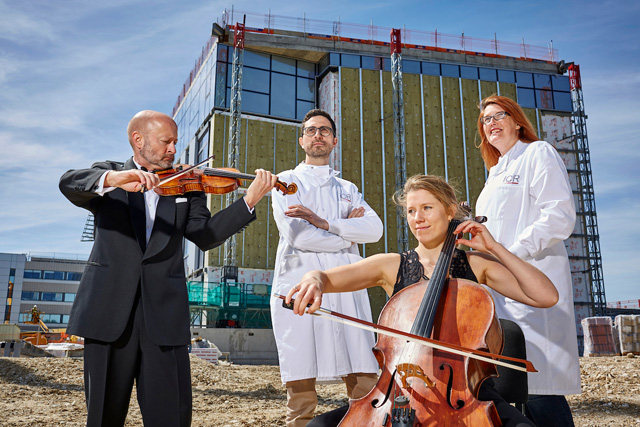
Callum Hüseyin and the Royal Philharmonic Orchestra, Let’s Finish It. The Centre for Cancer Drug Discovery building site. Photo courtesy Institute of Cancer Research.
AMc: Are you finding with this piece that a specific instrument might take on a specific story, or is it more a case of the dialogue between each of the instruments in a certain passage telling that narrative?
CH: The best way of describing it is that instruments are colouristic. I often conceive music – sometimes when I’m working things out – that hasn’t been coloured in yet. Then you think: “Oh, yes, that instrument there would be a very beautiful solution because it would give that kind of colour.” Other times, you actually think of sound and instruments themselves and that in itself provides musical material: the darkness of trombones, for example. In such cases, you really want to give them something really good so you know they will play really well. Every instrument has its quirks and things it does well and things it doesn’t do so well. Players are like this, too: you do sometimes write with particular instrumentalists or singers in mind.
The stories themselves tend to manifest in the shape of lines and pace and build, things like that: cadence and relaxation and breathing – all of the things that are going on under the surface of the music that make it what it is. They are in there deep. It’s not just a case of: “This is a sad story, so I should put that on an oboe because it sounds like a crying person.” It’s more about the physicality of playing. That’s the wonderful thing about live classical orchestral music – you get a bunch of people together to play this stuff and what it’s like has a lot to do with how they use their bodies to play their instruments. One of the reasons horns sound epic is that they are incredibly long pieces of tube that are being played with herculean effort by people blowing really hard. The bow of the violin can be drawn over the strings delicately, smoothly and calmly, or you can really hack into it hard. That affects the sound. That’s what drives a lot of music-making. It is a performance art; it’s not just an aural art. In that way, it’s quite different from electronic music, or other kinds of music, where the physicality of playing it is secondary to the art. For this, we made a recording, but I think of the music as much more like a classical piece of concert music.
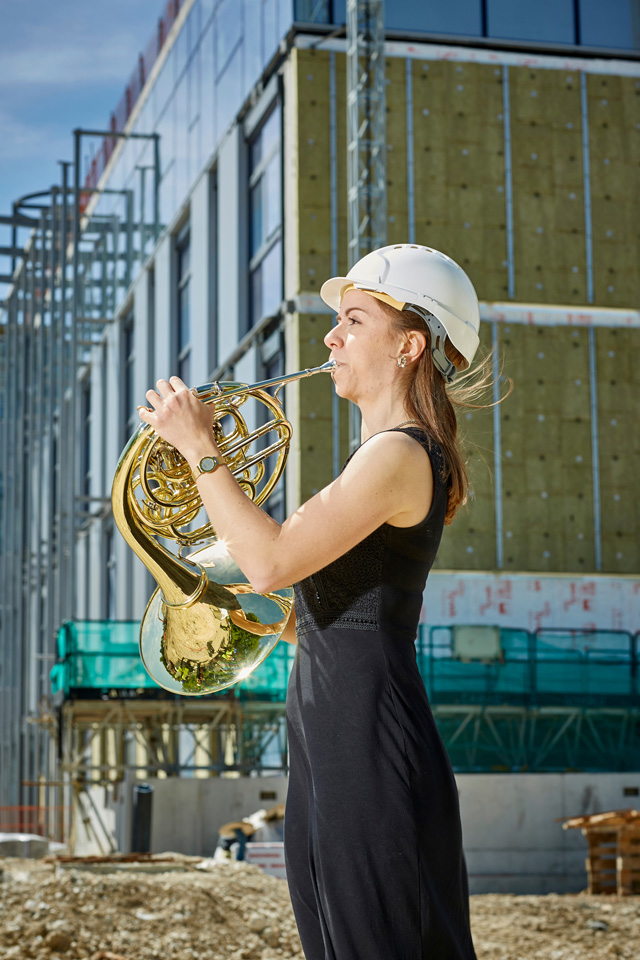
Callum Hüseyin and the Royal Philharmonic Orchestra, Let’s Finish It. The Centre for Cancer Drug Discovery building site. Photo courtesy Institute of Cancer Research.
We will play it live when the building opens – with its ending that will then be written – and I hope very much it will be played again and again by different people. Part of the artistic experience is watching people play the instruments. You have an engagement with the stories and the music because something is difficult to play, or something is easy to play, or something feels very tense to play. That is communicated to the audience. There is no such thing as easy music, but the kind of almost balletic way that instrumentalists have to play sometimes informs everyone’s understanding of the drama or narrative of the piece.
AMc: Would you say the piece is not fully set in stone in the form you are writing it down in until you have the orchestra there and you hear it being played?
CH: On a practical level, you can’t make many changes in the studio because you have to prepare lots of things, and anything you change in one part will have an effect on other things. But interpretation is a funny kind of art. It’s like a play: you don’t change the script, but you can change the staging, the volumes and all sorts of other things. Composing is the art of nearly giving someone all the things they need and just leaving enough room to have an artistic conversation in the moment. And there being room for interpretation.
One of the big things we were creating in the studio with the orchestra was the style, the way of playing, because instrumentalists have a lot of options about how they play something. The piece has an interesting challenge in that there are some big swooping melodies, and the tendency in playing that kind of music, particularly for an experienced concert orchestra, is to play it in a very 19th-century, early 20th-century way, with lots of wide vibrato on the strings, very romantic – think candlelit solo violin, that kind of thing. This piece is not about that at all. It has to have that swooping side of things, but it also has to be clean, precise and exact.
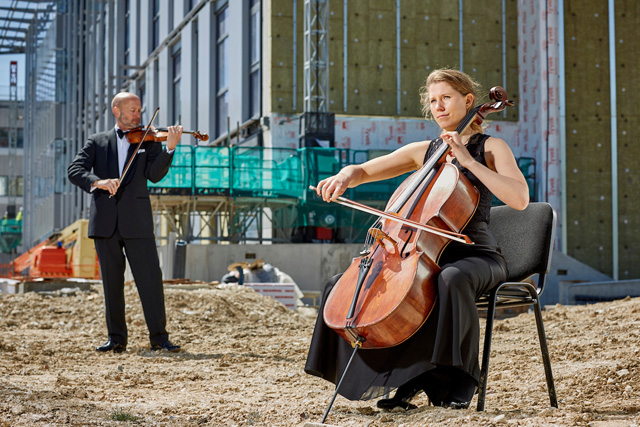
Callum Hüseyin and the Royal Philharmonic Orchestra, Let’s Finish It. The Centre for Cancer Drug Discovery building site. Photo courtesy Institute of Cancer Research.
The context of that is something you have to do in the studio. You mark it on the score, only a little bit of vibrato, and certain bowings and other things like that, but you have to convince your musicians, and that’s what conductors do as much as composers. I was sitting in the booth during the recording. Obviously, you talk to the conductor beforehand about how you want things, but, in the studio, you trust the conductor to get on with how you have asked for it to be done and how you have made it clear on the score that you want it done. But you are in everyone’s ear. Most of our classical composers are dead and it is like gold dust for us to have a composer there in person saying: “This is how it should be.” Imagine if you discovered a lost letter from Mozart that said: “In bar 73 of my piano concerto, I really wanted it like this.” It’s so authentic, so brilliant, to have directions from the composer about how to do something at the recording studio so, of course, when that’s you, you feel you have a lot of responsibility. And it means we get to decide those kinds of things, and sometimes you ask for things a certain way and then someone puts their hand up politely and says: “Why don’t we try it like this?” Or I ask them to play both ways and we pick the one we like most. There is an experimental aspect. There’s a very fine line in the recording studio, because time is money, and you don’t want to be doing that all the time, but it’s a valuable balance and it keeps it interesting for the players as well.
AMc: Was the first time you heard the piece played when you got to the recording studio?
CH: I played it myself on the piano a number of times and we can create virtual mock-ups these days with clever bits of software. There is a catch-22, in a way, because the more you have been trained musically, the more you can tell the difference between a live orchestra and a synthetic mock-up. Computers don’t breathe. The more trained your ears are, the more you can pick up on that. So, yes, that was the first time I heard it. It was the first time anyone heard it, really.
Also, every time someone plays it live, that’s the first time you’ve heard it, because it’s different every time. That’s the magic of it. Live classical music is acoustic, with no amplification, no autotune, and no tweaking of anything. You change things all the time based on where you are, though. If I played this with a youth orchestra, they would play it in a different way, because they are in their teens or early 20s. If you are in a cathedral, you have, in general, to play things more slowly, because there is an echo, there is a big boom, so if you play too fast, things are thrown together and sound like sludge. All of these things have different effects on the music and how you are feeling when you play it and hear it. It has not always been like this in the history of classical music. There have been times when the desired thing was for every performance to be the same, but that was very much late 20th-century fashion, which seems to have gone, thankfully, because it’s quite authoritarian. This piece is a true collaboration. You can’t go and impose things. The most important skill of the composer is to listen.
AMc: That is surely also a lesson that can be learned for the whole concept of cancer research and the collaboration between scientific researchers and patients?
CH: Yes, it’s all about working together, mutual respect and interconnectivity. As individualised medicine becomes a bigger deal, that connection between medical professionals, researchers and patients is ever closer. Because of the research that people like those at the ICR are doing, you aren’t just patient 743 with breast cancer any more. Everyone is different, an individual.
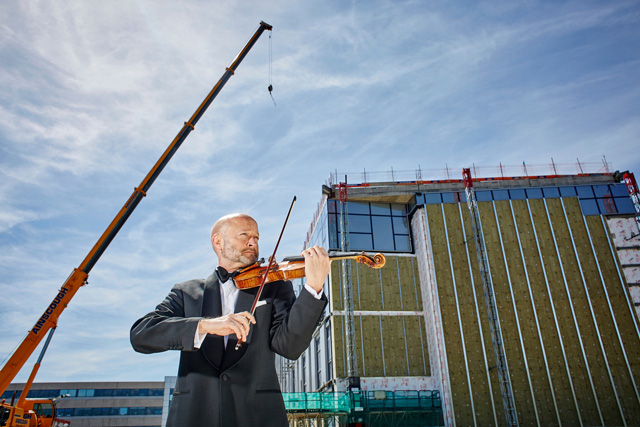
Callum Hüseyin and the Royal Philharmonic Orchestra, Let’s Finish It. The Centre for Cancer Drug Discovery building site. Photo courtesy Institute of Cancer Research.
AMc: And everyone needs slightly different drug combinations and doses.
CH: That’s it. And that is something, in this era of medicine, that we have the technology and the ability, with support from funding, to do. That’s very exciting.
AMc: Can you say a little bit more about how you go about writing music?
CH: The first thing is that it’s different every time. I work in a set of different musical fields, some of which are very involved with clients or organisations or collaborators. You spend quite a bit of time working out together what is wanted from a particular project, and that is usually the thing that takes the longest. You’re working out where to start. It’s not like booking a wedding band or a videographer; you’ve got to book lots and lots of musicians and you have to know in advance that you want 27 violinists, not 26. That’s fun. It’s my home turf. I love helping people. That’s why I’m in this world. While I am going through this with the organisations involved, I sketch some of the practicalities on manuscript paper with a fountain pen or pencil – just anything that comes to mind from what I am hearing. In this instance, I was given a huge packet of things to read and interviews and we met various people who all inspired me.
Inspiration is a funny thing because it’s really rare that something strikes you instantly, and you have the whole thing in your head immediately. It does happen, but not very often. In this case, I began by sketching ideas and started from a couple of personal things that I knew and some researchers I knew who worked with scientists. I also began exploring chords, sounds and melodies. Then I sat down to write, and I made a mood board, which included various other tracks of music my collaborators liked, lots of images, ideas and words. I had that on one side of the piano, manuscript paper on the other side, and I wrote. I tend to write in three- or four-hour blocks, with a pot of tea and a rubber, because I spend a lot of time rubbing out.
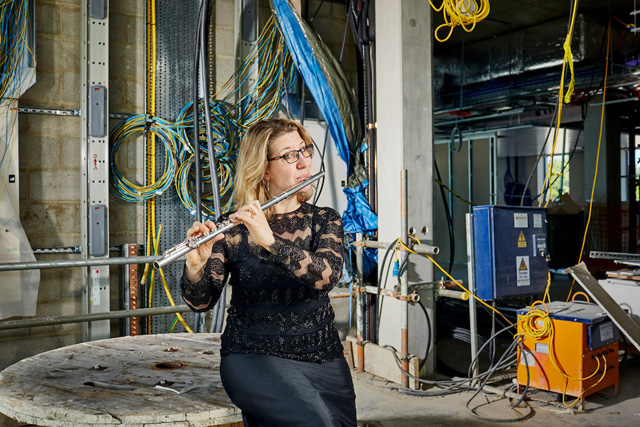
Callum Hüseyin and the Royal Philharmonic Orchestra, Let’s Finish It. The Centre for Cancer Drug Discovery building site. Photo courtesy Institute of Cancer Research.
Sometimes, you write with an instrument and you play – in my case, most of the time, on the piano – and you improvise and explore things. Sometimes, you just imagine and sketch in a mixture of not-coloured-in music. You just set up a few staves – five-line units – and three or four of those work well enough for anything, in a sketch form. Or, sometimes, you have really clear ideas about orchestration already, so you get all the instruments laid out. Flute one, flute two, horn seven. You work on lots of different pages at once, because you combine them later.
This piece had a reasonable gestation period of sketching. Some pieces are very quick, it becomes very obvious what your material is going to be. You’ve got different studies, a bit like when you do a painting, study the hands, study the feet, work out draperies and things like that. You do that with tunes and music and accompaniments. Sometimes, that is very quick, but I spent a good few hours on it. I also work on a lot of projects at once, so I have days off from certain projects and work on other things and then come back to them.
I probably wrote half of this piece by hand. Then I thought: “Yes, I think I know where this is going – time to get the computer out.” These days you can write on various pieces of software that create a score and do all sorts of things automatically for you, such as quoting the individual parts for musicians. It all used to have to be done by hand and took hours. So, I moved to the computer about halfway through. Then you have sessions where you spend hours looking at the score asking: “Is this right? Do I mean precisely this note here?” Then you change it, then you change it back, and you want to get it right, and you think: “Actually, this is slightly too long, this is slightly too short, this is slightly too loud, this is not rich enough, and six horns here is overkill.” Then you finish. At some point you have to say: “This is done”, which is the hardest part, because you always want to tinker, because you never know what it is really going to sound like until you’re in the concert hall. The worst thing you can do as a composer is to go to the first rehearsal and then go home and change everything, because it won’t have been played perfectly the first time. You have to be quite brave and realise: “It wasn’t perfect, but, actually, I think I am right, and it’s they who are wrong. Or they’re not quite there yet.”
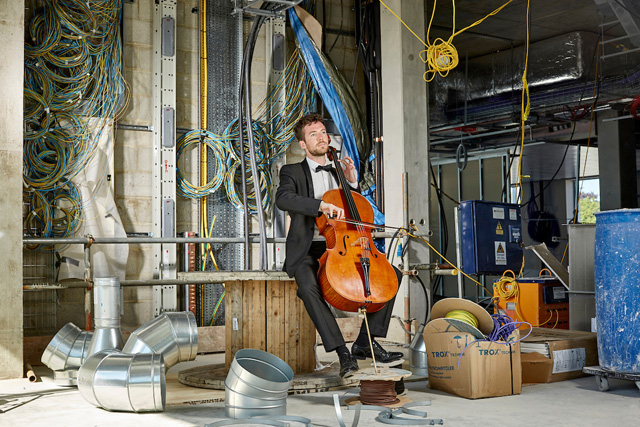
Callum Hüseyin and the Royal Philharmonic Orchestra, Let’s Finish It. The Centre for Cancer Drug Discovery building site. Photo courtesy Institute of Cancer Research.
You have to come to a point where you can say: “Yes, I’m happy this is essentially what I want it to be.” Then you have to put it away and come back to it a bit later on and go through it, proofing with a fine-tooth comb. That’s the bit that takes the longest, because you have to make sure what’s in your head is on the page: if you want a passage to be loud, you mark an F for forte, and you have to make sure everyone has got it all in the same place. And anything you have put in as shorthand has to be rewritten into a form that everybody will understand. You also have to ensure even basic things, such as that there are no page turns in the orchestral musicians’ parts in places where they would have only a few seconds to turn the page. Or else you’ve got to make a note for the orchestral manager or librarian to have a three-sheet, sticky-taped arrangement.
All of this practical stuff, which sounds really silly and mundane, is the most important part of the whole business because it is what makes the piece playable, having the notation as precise and accurate as you can make it. The worst thing in rehearsal is for someone to put up their hand and say: “I have a question about bar seven.” That should have been sorted. You spend time doing all of that and then you send it off and think: “I wonder what that’s going to sound like?”, which is nerve-racking. In this case, I had it done a couple of weeks before the first recording session, which is a nice amount of time. Depending on how long you have, and who you are, you either forget about it or you worry. I’m very busy, so I worry about it when I remember it exists, but otherwise I try not to think about it too much, because you inevitably want to change it and that means ringing up the orchestral manager and saying: “I’m really sorry but I need to make the following changes.”
AMc: That presumably wouldn’t make you very popular?
CH: No, and it is very important, if you want to be a composer, that, regardless of whether the musicians actually like your music, they are happy to play for you because it is a pleasant experience. That might sound silly, but it’s their job, and it’s my job, too. In the same way, you don’t have to like everyone you interview, but there is difference between not liking an interviewee and someone who is pleasant to interview and doesn’t cause you any problems. You might not agree with what they are saying, but at least they are not causing any issues.
AMc: Absolutely! It must work both ways, too, presumably, if you are selecting an orchestra or musicians you want to work with?
CH: Yes, you can ask people informally or arrange for the message to get to someone that you are thinking of coming on such-and-such a day and would really love them to put it in their diary. I love being a musician because, despite the tribulations and worries – never quite knowing where the next commission will come from and what it might be and where in the world you might have to do it – it is always a lot of fun. You are there for a reason.
The thing is: music is terribly difficult as an art form. It’s really difficult to write music and it is really difficult to play. If there were any other way of trying to express the things we express through music, we would use it, we really would. Why would we continue to do all these complicated things, such as making wood into very specific shapes and winding steel wires into string and spending hours looking at manuscript paper and trying to convince people to pay hundreds of thousands of pounds to create orchestras to play music for seemingly no profit whatsoever? Then it’s over. Once you have created the product, it has instantly gone. If there were any other way of doing it, we would, but there isn’t. The things that are said in music are therefore usually very important. Some people say there is an addiction to playing sound as an experience, and that is that, but it’s also quite a moral and spiritual and artistic need that we have, all of us have as people, to listen to it, and many of us have to sing or play or tap along.
AMc: Visual artists are also always talking about the need they have to create.
CH: The need and the joy. It’s easy to pathologise and to get into the late 19th-century, early 20th-century tortured artist thing, but it isn’t all of that. There is a lot of joy and a lot of sadness. It can be a very intense experience, when you are telling a sad story, in the act of creating it. If you are writing 20 seconds of music, depending on how you are orchestrating it, you might spend hours and hours and hours on those 20 seconds – or weeks, or months even. Things become very intense, but then, of course, it’s just 20-seconds long when somebody hears it. Sometimes, in a performance, we just miss it completely.
AMc: But, at other times, those 20 seconds could change someone’s life.
CH: Exactly! And that’s certainly the case for every classical musician I know. The musicians I know, classical musicians particularly, are all incredibly highly educated, highly intelligent people, who could all be making tons of money somewhere or doing other things, wonderful amazing things that would make them happy, but they all had a musical experience that changed their lives, and so they do what they do. You wander in and out of your commitment to that at different stages in your life, as other things happen, but it is a love affair.
AMc: What was it for you?
CH: I was too young to remember, but there were certainly some key moments. There are stories of me playing piano that come from before I remember. I don’t know precisely what might have happened or what I was thinking. Certainly Walt Disney’s Fantasia is key, and that figures in lots of people’s stories. You’d be surprised how often you go to a conference or talk to orchestral members around the world – particularly musicians from non-musical backgrounds – and if you asked them to put their hands up if they saw Disney’s Fantasia and it made them want to do music, a lot of them would, because it’s brilliant.
There are some key Tom and Jerry cartoons as well, such as the Oscar-winning Cat Concerto from 1947. You see a performance that is simply engaging. Even Bach, the grandfather of music, writes in his diary in 1705 about spending days walking miles and miles (250 to be more precise) across the German countryside to hear this man called Buxtehude play the organ. Thankfully, I just had to watch a video.
You can guess from my surname that western classical music has not always been part of my family’s life, but my mum got promoted when I was five and I remember sitting on the train with her – we lived in Walthamstow [in north-east London] at the time – going from Walthamstow Central to Chingford, or possibly the other way, and she said something like: “Callum, I’ve been promoted, and we’ve got some extra money, so you can do something after school. Do you want piano lessons or ballet or drama class?” I chose piano. Two weeks later, I started playing the piano, aged five, and I just kept doing it. I got into composition through working on a school holiday project to make a film, when I was about 13, and I wrote some of the music for it. Then I auditioned for the junior department at the Guildhall School of Music and Drama, which runs on a Saturday. I went up to London (by then, we had moved to near Brighton), had lessons in composition and piano and started conducting a couple of years after that. Then, eventually, when it came down to choosing my degree, I chose music. I had been thinking about becoming a mathematician, but I decided I could do maths whenever I wanted, and there’s always the Open University. I knew I couldn’t give up the music and I wanted to try to make a go of it. So I did. And here we are.
AMc: You are also musical director of Opera Kensington, a non-profit organisation that aims to provide performance opportunities for aspiring singers, composers, conductors, musicians and stage directors, as well as offering affordable opera to the local community.
CH: Yes. I didn’t really stop playing the piano, but I wasn’t doing much of it during parts of my degree and, towards the end of it, a lot of singer friends I knew needed people to play opera, so I started playing much more seriously again. Then I helped out at an opera company for a couple of months. One of the singers from that, Edwin Dizer, called me up a couple of months later and said they needed a musical director for their production of the Strauss operetta Die Fledermaus. I liked him very much, and he was good to work with, so I said: “Yes, I can do that.” I did, and, at the end, Ruby Cheney, who runs Opera Kensington, said: “You are very good, why don’t you stay on as our guy?” So I do that now and I’m just finishing up The Magic Flute at the moment.
It’s just a little company designed to give emerging and developing singers as many opportunities as possible and I spend a lot of time coaching. I’m not really a teacher, but I have done a lot of tutoring and coaching over the years. I see that as different from teaching, because teaching is often about leading from the front and you set the syllabus and mark people. I take a listening approach and tend to want to work only once in a while. I’m not interested in having a classroom. I conduct orchestras, that’s not teaching, that has to have already happened. That’s different. The development of an opera singer takes place over many years. If you want to be Wagnerian, a huge-voice singer, you are still training in your 30s. When I say “younger singers”, the youngest singer I’ve got in the current production is 21, the eldest “young” singer is in their 30s, and the eldest cast member is in their 60s. It’s a long game. Composers and conductors don’t really retire either; we die.
I also recently discovered that you don’t stop having lessons, or paying for teaching from people who are better than you, basically until there is no one left who is better than you because your teachers have all died. It’s a bit like athletics in that, no matter how good you are, you always need a coach. Even if you are the world champion, you still need a coach. When you are training, when you are young, you don’t do that many concerts necessarily, you are working 9 to 5 practising or rehearsing, and you’re not paid for that. The system developed out of noblemen who used to have servants who were musicians and that’s what they did all day – that’s what they were paid to do. Today, you can’t afford to do it if you’re not from that kind of background, unless you have massive philanthropic support.
AMc: So you are all for trying to create more opportunities for people from all backgrounds to be able to become musicians?
CH: Yes, absolutely. It’s about making opportunities for people, but, in a way, that’s not the main thing. We also have a responsibility to society to make art possible, which means things such as travel shouldn’t be too expensive and rents can’t be too expensive. I think one of the most disgusting things I’ve ever come across and experienced myself is not being able to audition for a master’s course at music college because they have audition fees – just to have your CV looked at. Even if it’s “only” £50, that is quite a lot for someone. And you can’t just apply to the one place – you have to apply to five or six, then you have to travel there, and, if you are an instrumentalist, you need a piano accompanist, who also has rent to pay. It becomes absolutely absurd. The more pressure that is put on everyone’s everyday life, the harder art becomes, because it has to live in the space in between and, as this get smaller, only the richest can participate.
It’s not all doom and gloom though. There is a lot of wonderful stuff going on. The people you meet and the levels of commitment are astonishing. I remember a teacher who said: “I know your background and I know what you want to do and what you want to achieve, and I think you can do it. It’s hard though, you’re going to be lonely, you’ll be broke a few times, and you’ll experience genuinely not knowing how you are going to survive the next few months. If you are self-employed, you are often relying on people actually paying you and not being late.” This was one of the best lessons I ever had because he said, at this stage, you have to be aware of these things, and decide that it is worth it, because, if it isn’t worth it, you’ll be miserable for ever and you shouldn’t even try. You can always stop, but don’t put yourself through it unless you really want to, and you believe in the music and the sacrifices you’re going to make about travelling and living in hotel rooms and that side of it. There are lots of other wonderful things to it, meeting people and other languages, other cultural things that are brilliant.
It’s the same for people who paint – you spend time in an attic, basically. You give up lots of things about modern everyday culture because you don’t do after-work drinks in the same way. You don’t do watercooler conversations. I’m not one of those people who say this is a bad thing, because it’s different. It isn’t. As long as there is infrastructure, it will be fine. If people can get around, food is not too expensive, rent is not too expensive … If people can enjoy life and enjoy hobbies and have time with their children, it wouldn’t matter if offices weren’t a thing any more. It wouldn’t matter if robots did most of the work, even. It would only matter if there were no infrastructure to support this.
AMc: Overall, then, you think you have made the right decision? You’re happy with the path you chose, albeit a difficult one?
CH: It’s wonderful. And this kind of project is the sort of thing I absolutely love. These collaborations, and doing interesting things with different people whom I would never have otherwise met. I’m lucky enough to meet all sorts of people from all sorts of places and all walks of life and they are all, without fail, interesting. I love listening to people. I love experts – and everyone is an expert on something. Everyone has an interesting story to tell if you only listen. I fundamentally believe that.